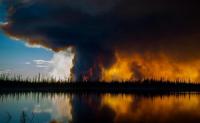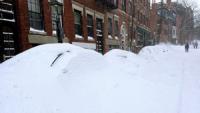-
Assessing climate resiliency of more than 250 U.S. cities
The University of Notre Dame’s Global Adaptation Initiative (ND-GAIN) has announced it will assess the climate vulnerability and readiness of every U.S. city with a population over 100,000 — more than 250 in all — in an effort to help inform decisions by city officials on infrastructure, land use, water resources management, transportation and other adaptive strategies. The Urban Adaptation Assessment (UAA) will also integrate a social equity analysis, which will investigate how vulnerable groups are disproportionately harmed by climate hazards, such as extreme heat, flooding and extreme cold.
-
-
Groundwater resources around the world could be depleted by 2050s
Human consumption could deplete groundwater in parts of India, southern Europe, and the United States in the coming decades, according to new research presented at the 2016 American Geophysical Union Fall Meeting. New modeling of the world’s groundwater levels finds aquifers — the soil or porous rocks that hold groundwater — in the Upper Ganges Basin area of India, southern Spain, and Italy could be depleted between 2040 and 2060.
-
-
The origins of Tennessee’s recent wildfires

Wildfires raged recently through the foothills of Tennessee’s Great Smoky Mountains, fueled by severe drought and high winds in the eastern part of the state. The fires damaged or destroyed more than 1,400 structures, including homes, chapels, and resort cabins. Fourteen people were killed, and nearly 150 others were injured. Last week, two juveniles were taken into custody and charged with aggravated arson in connection with the deadly wildfires – but sources such as Climate Central suggested that rising temperatures may have played a role in the fires. Does climate change play a role in determining the frequency and intensity of wildfires?
-
-
New approach calculates benefits of building hazard-resistant structures
The southeastern United States was hit hard by weather patterns resulting from Hurricane Matthew in October. Georgia has sustained some $90 million in insured losses to date, and total claims are expected to rise. Florida was spared Matthew’s worst effects, but the state is regularly witness to the destructive power of such storms and there’s a lot at stake: The insured value of residential and commercial properties in Florida’s coastal counties now exceeds $13 trillion. Calculation developed by MIT Concrete Sustainability Hub shows that when building in areas prone to natural disasters, it pays to make informed decisions.
-
-
Dust Bowl would devastate today’s crops: Study

A drought on the scale of the legendary Dust Bowl crisis of the 1930s would have similarly destructive effects on U.S. agriculture today, despite technological and agricultural advances, a new study finds. Additionally, warming temperatures could lead to crop losses at the scale of the Dust Bowl, even in normal precipitation years by the mid-twenty first century.
-
-
Freezing in record lows may raise doubts about global warming

If you are shivering from unusually teeth-rattling cold this holiday season, global warming is probably the last thing on your mind. “The local weather conditions people experience likely play a role in what they think about the broader climate,” says one expert. “Climate change is causing record-breaking heat around the world, but the variability of the climate means that some places are still reaching record-breaking cold. If you’re living in a place where there’s been more record cold weather than record heat lately, you may doubt reports of climate change.”
-
-
Accelerating sea level rise requires collaborative response: Experts
Recent estimates suggest that global mean sea level rise could exceed two meters by 2100. The projections pose a challenge for scientists and policymakers alike, requiring far-reaching decisions about coastal policies to be made based on rapidly evolving projections with large, persistent uncertainties. Policymakers and scientists must thus act quickly and collaboratively to help coastal areas better prepare for rising sea levels globally, say climate change experts.
-
-
Bird-inspired drone navigation
When they need to change direction, increase their speed, or counter headwinds, birds alter the configuration of their wings. To steer, for example, they spread one wing and slightly retract the other. By adjusting their wingspan in this way, they create a calculated imbalance that causes them to turn. Up to now, only birds could do this so effectively. Researchers have equipped a drone with feathers to increase its precision during flight. The bio-inspired device can spread or close its wings while flying, making it easier to maneuver and more resistant in high winds.
-
-
Firefighters to have bushfire predictions at the fingertips
Researchers at the University of Western Australia are developing a new touchscreen device that can be mounted in a fire truck to help firefighters predict where and when a bushfire will spread. The researchers are modifying bushfire simulation software Australis into a high-end tablet to provide accurate predictions of fire behavior more rapidly than current methods.
-
-
Safer, long-life nuclear reactors: Metal design may raise radiation resistance by 100 times
The big problem faced by metals bombarded with radiation at high temperatures—such as the metals that make up nuclear fuel cladding—is that they have a tendency to swell up significantly. They can even double in size. In findings that could change the way industries like nuclear energy and aerospace look for materials that can stand up to radiation exposure, researchers have discovered that metal alloys with three or more elements in equal concentrations can be remarkably resistant to radiation-induced swelling.
-
-
Climate engineering uncertainties limit its use in slowing climate change
Climate engineering refers to the systematic, large-scale modification of the environment using various climate intervention techniques. A new suggests that the uncertainties associated with climate engineering are too great for it to provide an alternative to the rapid reduction of greenhouse gas emissions.
-
-
Remote-control skillful rescue robot demonstrated
Researchers have developed a prototype construction robot for disaster relief situations. This prototype has drastically improved operability and mobility compared to conventional construction machines.
-
-
Identifying, fast-tracking development of first responders technology
First responders face challenging conditions while often carrying heavy and outdated equipment. Wearable technology is on the rise, estimated at a $10 billion dollar commercial market, and advances are happening in the health and fitness area every day. The first responder community stands to benefit from integrating some of this otherwise heavy and outdated equipment into wearable technology, improving both upon efficiencies and responsiveness as well as continuing to prioritize their own safety on the frontlines of often dangerous situations.
-
-
Accelerating sea level rise threatens communities, infrastructure in NY, NJ, Conn.
Parts of the New York, New Jersey, and Connecticut metropolitan area are at risk of being permanently flooded by sea level rise. A new study details the severe threats posed to the region’s bay areas, coastal urban centers, beach communities, and airports and seaports by as little as one foot of sea level rise, a possibility as soon as the 2030s. Sea level rise already has begun to affect communities and critical infrastructure in the region, and presents tough decisions for vulnerable areas.
-
-
U.K. winter 2015-16 floods: One of the century’s most extreme and severe flood episodes
A new scientific review of the winter floods of 2015-2016 confirms that the event was one of the most extreme and severe hydrological events of the last century. The new hydrological appraisal brings together both river flow and meteorological data in an analysis of the events that led to extensive river flooding in northern England, Scotland, Northern Ireland, and parts of Wales over a three-month period.
-
More headlines
The long view
New Technology is Keeping the Skies Safe
DHS S&T Baggage, Cargo, and People Screening (BCP) Program develops state-of-the-art screening solutions to help secure airspace, communities, and borders
Factories First: Winning the Drone War Before It Starts
Wars are won by factories before they are won on the battlefield,Martin C. Feldmann writes, noting that the United States lacks the manufacturing depth for the coming drone age. Rectifying this situation “will take far more than procurement tweaks,” Feldmann writes. “It demands a national-level, wartime-scale industrial mobilization.”
How Artificial General Intelligence Could Affect the Rise and Fall of Nations
Visions for potential AGI futures: A new report from RAND aims to stimulate thinking among policymakers about possible impacts of the development of artificial general intelligence (AGI) on geopolitics and the world order.
Smaller Nuclear Reactors Spark Renewed Interest in a Once-Shunned Energy Source
In the past two years, half the states have taken action to promote nuclear power, from creating nuclear task forces to integrating nuclear into long-term energy plans.
Keeping the Lights on with Nuclear Waste: Radiochemistry Transforms Nuclear Waste into Strategic Materials
How UNLV radiochemistry is pioneering the future of energy in the Southwest by salvaging strategic materials from nuclear dumps –and making it safe.
Model Predicts Long-Term Effects of Nuclear Waste on Underground Disposal Systems
The simulations matched results from an underground lab experiment in Switzerland, suggesting modeling could be used to validate the safety of nuclear disposal sites.
